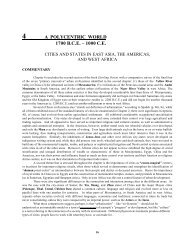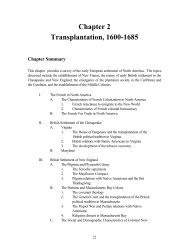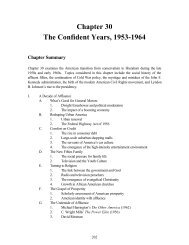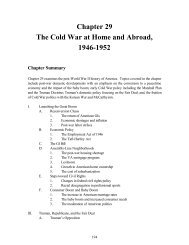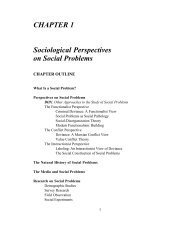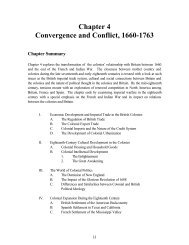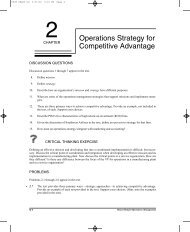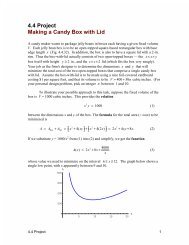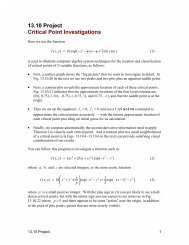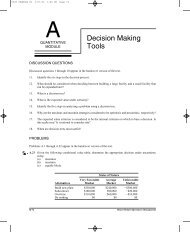Merchandising Operations and the Accounting Cycle - Pearson
Merchandising Operations and the Accounting Cycle - Pearson
Merchandising Operations and the Accounting Cycle - Pearson
You also want an ePaper? Increase the reach of your titles
YUMPU automatically turns print PDFs into web optimized ePapers that Google loves.
OBJECTIVE S4<br />
Adjust <strong>and</strong> close <strong>the</strong> accounts<br />
of a merch<strong>and</strong>ising business<br />
under <strong>the</strong> periodic inventory<br />
system<br />
KEY POINT<br />
Recall that Purchases (not<br />
Inventory) was debited for<br />
merch<strong>and</strong>ise purchased. In <strong>the</strong><br />
periodic system, no entries are<br />
made to <strong>the</strong> Inventory account for<br />
purchases or sales. Beginning<br />
inventory remains on <strong>the</strong> books<br />
<strong>and</strong> on <strong>the</strong> trial balance until<br />
ending inventory replaces it at <strong>the</strong><br />
end of <strong>the</strong> period.<br />
KEY POINT<br />
If you were preparing a work<br />
sheet, you could omit <strong>the</strong> adjusted<br />
trial balance columns. Once you<br />
underst<strong>and</strong> <strong>the</strong> mechanics of <strong>the</strong><br />
work sheet, you can take a trial<br />
balance amount, add or subtract<br />
<strong>the</strong> adjustments, <strong>and</strong> extend <strong>the</strong><br />
new amount to ei<strong>the</strong>r <strong>the</strong> income<br />
statement or balance sheet<br />
column.<br />
282 Part One The Basic Structure of <strong>Accounting</strong><br />
Adjusting <strong>and</strong> Closing <strong>the</strong> Accounts<br />
in a Periodic Inventory System<br />
A merch<strong>and</strong>ising business adjusts <strong>and</strong> closes <strong>the</strong> accounts much as a service entity<br />
does. The steps of this end-of-period process are <strong>the</strong> same: If a work sheet is used,<br />
<strong>the</strong> trial balance is entered <strong>and</strong> <strong>the</strong> work sheet completed to determine net income<br />
or net loss. The work sheet provides <strong>the</strong> data for journalizing <strong>the</strong> adjusting <strong>and</strong><br />
closing entries <strong>and</strong> for preparing <strong>the</strong> financial statements.<br />
At <strong>the</strong> end of <strong>the</strong> period, before any adjusting or closing entries, <strong>the</strong> Inventory account<br />
balance is still <strong>the</strong> cost of <strong>the</strong> inventory that was on h<strong>and</strong> at <strong>the</strong> end of <strong>the</strong> preceding<br />
period. It is necessary to remove this beginning balance <strong>and</strong> replace it with<br />
<strong>the</strong> cost of <strong>the</strong> inventory on h<strong>and</strong> at <strong>the</strong> end of <strong>the</strong> period. Various techniques may<br />
be used to bring <strong>the</strong> inventory records up to date.<br />
To illustrate a merch<strong>and</strong>iser’s adjusting <strong>and</strong> closing process under <strong>the</strong> periodic<br />
inventory system, let’s use Austin Sound’s December 31, 2004, trial balance in Exhibit<br />
5S-4. All <strong>the</strong> new accounts—Inventory, Purchases, Freight In, <strong>and</strong> <strong>the</strong> contra accounts—are<br />
highlighted for emphasis. Inventory is <strong>the</strong> only account that is affected<br />
by <strong>the</strong> new closing procedures. The additional data item (h) gives <strong>the</strong> ending inventory<br />
figure $40,200.<br />
Preparing <strong>and</strong> Using <strong>the</strong> Work Sheet in a Periodic<br />
Inventory System<br />
The Exhibit 5S-5 work sheet on page 284 is similar to <strong>the</strong> work sheets we have seen<br />
so far, but a few differences appear. This work sheet is slightly different from <strong>the</strong> one<br />
you saw in Chapter 4; it does not include adjusted trial balance columns. In most accounting<br />
systems, a single operation combines trial balance amounts with <strong>the</strong> adjustments<br />
<strong>and</strong> extends <strong>the</strong> adjusted balances directly to <strong>the</strong> income statement <strong>and</strong><br />
balance sheet columns. Therefore, to reduce clutter, <strong>the</strong> adjusted trial balance<br />
columns are omitted so that <strong>the</strong> work sheet contains four pairs of columns, not five.<br />
Account Title Columns The trial balance lists a number of accounts without balances.<br />
Ordinarily, <strong>the</strong>se accounts are affected by <strong>the</strong> adjusting process. Examples<br />
include Interest Receivable, Interest Payable, <strong>and</strong> Amortization Expense. The accounts<br />
are listed in <strong>the</strong> order <strong>the</strong>y appear in <strong>the</strong> ledger. If additional accounts are<br />
needed, <strong>the</strong>y can be written in at <strong>the</strong> bottom, above net income.<br />
Trial Balance Columns Examine <strong>the</strong> Inventory account, $38,600 in <strong>the</strong> trial balance.<br />
This $38,600 is <strong>the</strong> cost of <strong>the</strong> beginning inventory. The work sheet is designed to replace<br />
this outdated amount with <strong>the</strong> new ending balance, which in our example is<br />
$40,200 [additional data item (h) in Exhibit 5S-4]. As we shall see, this task is accomplished<br />
later in <strong>the</strong> columns for <strong>the</strong> income statement <strong>and</strong> <strong>the</strong> balance sheet.<br />
Adjustments Columns The adjustments are similar to those discussed in Chapters<br />
3 <strong>and</strong> 4. They may be entered in any order desired. The debit amount of each entry<br />
should equal <strong>the</strong> credit amount, <strong>and</strong> total debits should equal total credits. You<br />
should review <strong>the</strong> adjusting data in Exhibit 5S-5 to reassure yourself that <strong>the</strong> adjustments<br />
are correct.<br />
Income Statement Columns The income statement columns contain adjusted<br />
amounts for <strong>the</strong> revenues <strong>and</strong> <strong>the</strong> expenses. Sales Revenue, for example, is $169,300,<br />
which includes <strong>the</strong> $1,300 adjustment.<br />
You may be wondering why <strong>the</strong> two inventory amounts appear in <strong>the</strong> income<br />
statement columns. The reason is that both beginning inventory <strong>and</strong> ending inventory<br />
enter <strong>the</strong> computation of cost of goods sold. Placement of beginning inventory<br />
($38,600) in <strong>the</strong> work sheet’s income statement debit column has <strong>the</strong> effect of adding



